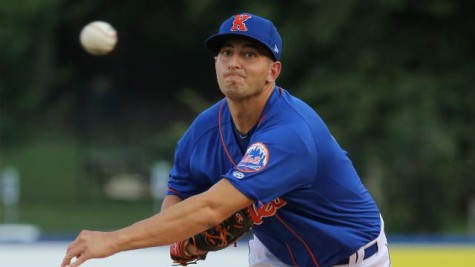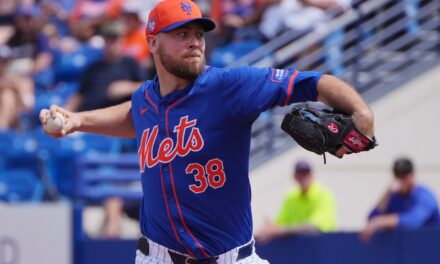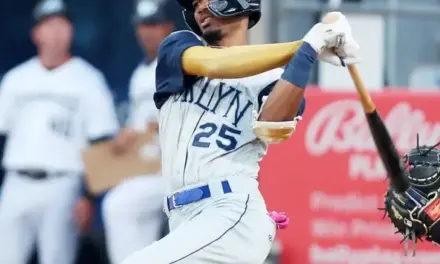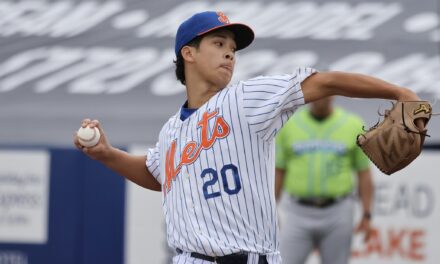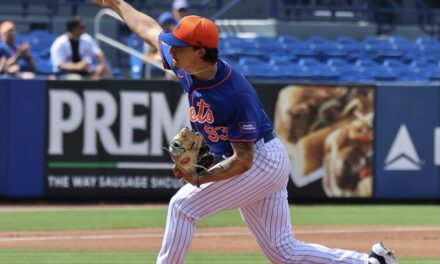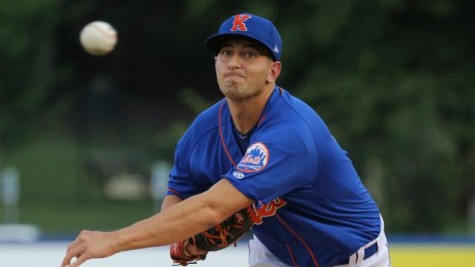
Photo Credit: Allen Greene Photography
Thomas Szapucki
Position: SP Bats/Throws: R/L Age: June 12, 1996 (22)
Acquired: 2015 Fifth Round Draft Pick from William T. Dwyer High School (West Palm Beach, FL)
Previous Rank: 8
2017 Stats (Columbia): 1-2, 2.79 ERA, 1.172 WHIP, 3.1 BB/9, 8.4 K/9
Very early on, it was clear Szapucki was the real gem from the Mets 2015 draft. In 2016, he was 4-3 with a 1.38 ERA, 0.885 WHIP, and a 14.9 K/9 in nine starts between Kingsport and Brooklyn. With that performance,. everyone took note of what a promising pitcher the Mets had on his hands.
Baseball America rated Szapucki as the the eighth best prospect in the Appalachian League as well as naming him a Rookie All-Star. Baseball Prospectus thought more highly of him ranking him as the 69th best prospect in baseball. As impressive as that seems, Keith Law of ESPN ranked Szapucki as the 60th best prospect in baseball.
After this, you would have expected Szapucki to continue to rise up the prospect lists, and quite possibly, you would’ve thought he could have made his Major League debut by now. At the very least, you would have expected Szapucki to be in a position where he would be a factor in the Mets 2019 season. So far, that has not happened.
The main reason for that is injuries. Szapucki’s breakout 2016 season ended with a back injury. He would show no ill-effects of that injury during the 2017 season. However, he would start the season with a shoulder impingement, and he would last just six starts for Columbia. Fresh off being named the South Atlantic League Pitcher of the Week, Szapucki was diagnosed with a torn UCL requiring season ending Tommy John surgery. It cost him not just the bulk of the 2017 season, but it also cost him the entire 2018 season.
With Szapucki gone last year, it not only cost him a year of development, but it would also cost us all the opportunity to see him go out and do things like strike out the side:
When Szapucki has been on the mound, you see the type of stuff which has gotten the Mets and scouts excited about him. In short time, Szapucki has gone from a pitcher whose fastball velocity ranged the spectrum from the low to high 90s to a pitcher who is routinely pitching in the mid 90s with the ability to top out around 97 MPH.
He throws that fastball from a three-quarters arm slot, which helps generate movement and velocity. At times, he can get some sinking action. It plays a factor in batters not having success trying to lift the ball as evidenced by his allowing just two homers in his professional career. The arm slot has the same effect with his secondary offerings.
The most impressive of his secondary pitches is his curveball. It is a classic curve which can be a knee buckler. It is an effective pitch which is effective against right and left handed batters. The pitch is so impressive MLB Pipeline has rated it not just as the best curveball in the Mets farm system, but also as the organization’s top breaking pitch.
So far, Szapucki has been impressive with those two pitches, and it has generated buzz about him and his potential. A pitcher with a mid 90s fastball and a knee buckling curve profiles well. That type of pitcher would profile much better with good control and with a third pitch.
Working backwards, Szapucki has promise with he change-up. The most important thing he does right with his change-up is how he throws it. All three of his pitches (fastball, curveball, change-up) are thrown from the same arm slot. As a result, he does not telegraph his pitches by arm slot. He also doesn’t telegraph by arm motion as he throws the change with a fastball action. The end result is a well disguised pitch with late tumbling action.
The biggest issue with the change is consistency.
Szapucki has shown the ability to throw all three of his pitches in all four areas of the zone. He has a feel for all of three of his pitches, and he has been able to throw it by batters. While he has the ability to control his pitches to the extent he can generate swings and misses, he still has yet to master control as far as location.
For example, in his career he has a 3.2 BB/9, including a 4.3 BB/9 in the New York-Penn League. On the surface, that is not a particularly high walk rate, However, when taking into account the level of competition he has faced and with players in the lower levels on the minors being more prone to being free swingers, that is a high walk rate for a pitcher who is seen as a prospect.
It should be noted when a pitcher returns from Tommy John one of the things which returns last is his control. That is to be expected when a pitcher has not pitched in a competitive environment in over a year. As a result, when any pitcher returns, the first thing to look for is velocity and movement. If those things return, the pitcher is on the comeback trail.
On a side note here, Szapucki tends to work with a more deliberate almost Steve Trachsel like pace, and he last pitched before the pitch clock was implemented across the minor leagues. It will be interesting to see how he adapts to working on a quicker pace at a time when he is trying to re-establish himself mechanically and mentally on the mound.
With respect to Szapucki, the bright side is he has had more than sufficient time to rehab from the surgery. The downside is with the Mets abandoning the Instructional Leagues, they have not had an opportunity to view him in an even semi-competitive environment. Still, he should get that chance in Spring Training. At that time, we can reasonably assume he is healthy with full velocity and movement on all of his pitches. After that, we should see him work on and hone his control putting him back on a path where he can be a mid-rotation or better starter.
Editor’s Note: Jarred Kelenic, Justin Dunn, Luis Santana, and Ross Adolph, were all in our original Top 25 before they were traded.
Previous Rankings
50-46 Led by Michael Paez
45-41 Led by Ranfy Adon
40-36 Led by Anthony Dirocie
35-31 Led by Ryley Gilliam
30-26 Led by Chris Viall
25 Carlos Cortes
24 Ali Sanchez
23 Eric Hanhold
22 Luis Carpio
21 Freddy Valdez
20 Walker Lockett
19 Junior Santos
18 Gavin Cecchini
17 Jordan Humphreys
16 Christian James
15 Tony Dibrell
14 Francisco Alvarez
13 Will Toffey
12 Adrian Hernandez
11 Desmond Lindsay
10 Franklyn Kilome
9 Shervyen Newton


